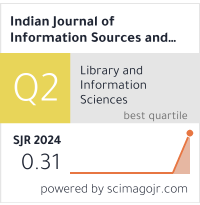Conservation and Digital Access of Available Rare Collections of Central Himalaya Region: A Study of Kumaun University
DOI:
https://doi.org/10.51983/ijiss.2018.8.1.507Keywords:
Rare Books, Manuscripts, Kumaun University, Central Himalaya, Digital, RepositoryAbstract
The main objective of the study is to conserve and preserve manuscripts/rare books available at DSB Campus, Kumaun University, Nainital, Uttarakhand, India. Eventually, digitized them and upload in digital repository software at G.B. Pant Library. A survey method is applied and twenty four (24) questionnaires are distributed to the twenty four (24) departments of DSB Campus, Kumaun University. In the survey, researcher got the total 53 rare books and 24 manuscripts from Zoology, Physics, Forestry, Sanskrit, and Hindi Departments. The manuscripts/rare books are not available in remaining nineteen (19) departments of this campus. Preventive and curative work is being done only in twenty four (24) manuscripts of Sanskrit Department, due to the scarcity of funds. After that the images was captured through camera then deciphering the manuscripts through subject expert and making digital repository of these rare documents in Dspace software. The result revealed that Zoology Department contains 44 (23008 folios) rare books of general zoology, entomology, fish and fisheries, genetics, invertebrates and amphibiology. Physics Department contains 1 (470 folios) rare books of spectroscopy. Forestry Department contains 3 (1208 folios) rare books of silviculture. Hindi Department contains 3 (500 folios) rare books aalochanaye and kavitaye and Sanskrit Department contains 24 (297 folios) manuscripts. The conservation process enrich the rare documents and digitization makes them global accessible. The purpose of this study is same and we have tried to make these said documents accessible within the library premises and save the rich heritage culture of Central Himalayan Region of Uttarakhand, India.
References
Smith, A. (2000). Real life choices. In A. Kenney & O. Reiger (Eds.), Moving theory into practice. Mountain View, CA: Research Libraries Group.
Panitch, J. M. (2001). Special collections in ARL libraries: Results of the 1998 survey. Washington, D.C.: Association of Research Libraries.
McKay, S. (2003). Digitization in an Archival Environment. Electronic Journal of Academic and Special Librarianship, 4(1).
Greene, M. A., & Meissner, D. (2005). More products, less process: Revamping traditional archival processing. The American Archivist, 68(2), 208-263.
Gaur, R. C., & Chakraborty, M. (2009). Preservation and access to Indian manuscripts: A knowledge base of Indian cultural heritage resources for academic libraries. In Delhi University Library System (Eds.), Proceedings of International conference on academic libraries: Globalizing academic libraries: Vision 2020 (pp. 90-98). New Delhi: Mittal.
Erway, R. (2011). Rapid Capture: Faster Throughput in Digitization of Special Collections. Dublin, Ohio: OCLC Research.
Downloads
Published
How to Cite
Issue
Section
License
Copyright (c) 2018 The Research Publication

This work is licensed under a Creative Commons Attribution-NonCommercial-NoDerivatives 4.0 International License.









